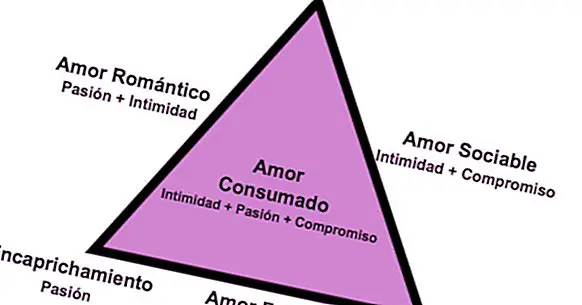The triangular theory of love of Sternberg
The triangular theory of love aims to explain the complex phenomenon of love and loving interpersonal relationships. It was proposed by the psychologist Robert Sternberg, and describes the different elements that make up love, as well as the possible combinations of these elements when forming different types of relationships.
It is considered a useful theory, since helps us to understand this very complex feeling which, in addition to being very important in our lives, is the basis of many of our interpersonal relationships.
- Recommended article: "The 14 types of couple: how is your relationship?"
Psychology and love
Love and falling in love is a very interesting topic, because it is one of the most intense feelings we can experience. Love affects us in all senses and when we meet that special person, it changes our lives completely. In fact, significantly modifies the way we perceive reality and it makes us make choices in a different way than usual, that we orient our relationships with others in another way, and that we rearrange our priorities about what matters in life.
When we fall in love, the intense emotions and passion that surrounds us affect our mind and body.
Therefore, psychologists, sociologists and doctors have tried to understand and explain it from different points of view (biological, cultural, etc.). In the last decades, Research in this field has been varied, seeking to understand falling in love, love, attraction or lack of love .
- If you want to know some conclusions of these studies, we invite you to read our post: "Love and falling in love: 7 surprising investigations"
The theory of love of Sternberg
One of the most well-known theories of love is the triangular theory of Sternberg. Robert Sternberg, is an American psychologist, professor at Yale University, widely recognized for his research. Not only has he been interested in love, but intelligence or creativity have also been objects of interest in his research in the field of Cognitive Psychology and emotions. In particular, his contributions in the field of the study of intelligence are well known.
But nevertheless, this character is known for his theory about love and interpersonal relationships and many experts in this field have supported their ideas.

Understanding your theory
For Sternberg, love is composed of 3 qualities that manifest in any love relationship: intimacy, passion and commitment. These elements, in practice, intermingle with each other, but knowing how to distinguish them in a theoretical framework helps us to understand the phenomenon of love and to better recognize its nuances and details. Below you can find a brief explanation about them.
- Privacy : Intimacy refers to the feeling of closeness, the connection between the two people who are part of the love story, the trust between them, friendship and affection.
- Passion : This component is the excitement or energy of the relationship. The feelings of physical attraction and the impulse or the need to be with the other person and to have intimate relationships.
- Commitment : It refers to the decision to continue in the relationship despite the ups and downs that may arise. It includes aspects such as the moments lived, the history of the relationship, etc.
These three elements represent the corners of the pyramid of Sternberg's theory, with intimacy at the highest point and commitment and passion on the sides. Depending on the combinations that occur between these components, the love relationships will be different. For example, in a new relationship, passion predominates over intimacy and commitment.
- Related article: "Types of love: what different kinds of love are there?"
Possible combinations or types of love
According to the possible combinations, Sternberg says that there are different ways of loving . These ways of loving can be understood in isolation or as stages:
1. Affection
Affection refers to true friendship . There is only intimacy, but there is no passion or commitment. The members of the relationship feel close and trust each other, but there is no desire to have intimate relationships or commitment as a couple.
2. Infatuation
In this way of loving there is a lot of passion, however, there is neither intimacy nor commitment , which makes this type of relationship superficial. It would be a kind of romance but it ends soon or the beginning of a relationship, in which there is much desire to have intimate relationships but there is not enough trust or commitment.
3. Empty love
Empty love is characterized by a high commitment, without passion or intimacy . This is usual in long-term or interested relationships, when there is no trust or intimate relationships, but there is a commitment to be together.
4. Romantic love
Romantic love is a way of loving in which the members of the relationship feel attraction and excitement , and, in addition, they have confidence and closeness. Romantic love has inspired thousands of novels and movies, it is the love that Romeo and Juliet feel. If this stage continues with great experiences together, it could end up causing commitment.
5. Sociable love
It usually occurs in long-term relationships. There is intimacy and commitment, but not passion . It is the kind of love that can manifest itself when the couple lacks desire and excitement towards the other person, but the coexistence, the children and the experiences together keep them together. This relationship may seem satisfactory to members and last a long time.
6. Fatuous love
In passionate love, passion and commitment predominate, but there is no intimacy . Fatuous love can occur because the members of the couple want to be together, because there is the desire and excitement to live intimate experiences, however, they do not have many things in common.
7. Accomplished love
This is complete love. It is formed by the three elements of Sternberg's pyramidal theory. The consummate love is the main love archetype, it is the ideal love and also receives the name of mature love .
- Do you want to know more about mature love? Visit our article: "Mature love: why is the second love better than the first?"
You have to work the three elements to achieve consummate love
Sternberg talks about "no love" when these three elements are not present in the relationship . The same author affirms that couples with consummate or complete love continue to share the intimate desire and passion at all levels, even after many years. However, Sternberg points out that maintaining consummate love is more complicated than achieving it, so it is necessary for couples to work on the three basic elements of their theory. After all, actions speak louder than words.
The balance between these three ingredients can change as a relationship progresses. However, time alone does not result in high intimacy, passion or commitment. Knowing these three ingredients of love can help actors recognize when they need to improve one of the elements, or it can help them make the decision to leave. Sternberg concludes that without the expression of the three components, even the most authentic love can die .
What happens in our brain when we fall in love?
Many experts say that love is a complex phenomenon, and despite the many investigations that have been conducted so far, there has not always been consensus among researchers. Falling in love, attraction and love are complex experiences in which cultural and biological factors interact.
- But, What happens in our brain when we fall in love? We answer this question in our article "The chemistry of love: a very powerful drug"



















